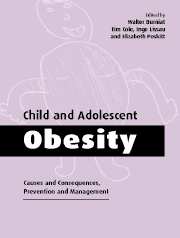Book contents
- Frontmatter
- Contents
- List of contributors
- Foreword
- Preface
- Part I Causes
- Part II Consequences
- Part III Prevention and management
- 12 Prevention
- 13 Home-based management
- 14 Dietary management
- 15 Management through activity
- 16 Psychotherapy
- 17 Drug therapy
- 18 Surgical treatment
- 19 Interdisciplinary outpatient management
- 20 Interdisciplinary residential management
- 21 The future
- Index
17 - Drug therapy
Published online by Cambridge University Press: 02 November 2009
- Frontmatter
- Contents
- List of contributors
- Foreword
- Preface
- Part I Causes
- Part II Consequences
- Part III Prevention and management
- 12 Prevention
- 13 Home-based management
- 14 Dietary management
- 15 Management through activity
- 16 Psychotherapy
- 17 Drug therapy
- 18 Surgical treatment
- 19 Interdisciplinary outpatient management
- 20 Interdisciplinary residential management
- 21 The future
- Index
Summary
The present chapter focuses on the current pharmacotherapy of obesity and agents under development. It is intended to update clinical practitioners especially paediatricians in this rapidly progressing field and to give indications for eventual drug support in childhood obesity. It should be noted, though, that few treatments are currently recognized and licensed for use in children.
The medical history of obesity dates back to the Stone Age (Bray, 1990). The first drug for the management of obesity, thyroid hormone, was introduced in 1893. It was believed to be therapeutic because overweight patients were thought to have a reduced metabolic rate. Dinitrophenol, a drug that was noted to increase metabolic rate due to the uncoupling of oxidative phosphorylation and to produce weight loss, was soon abandoned because of severe side effects. The development and synthesis of amphetamines initiated a new area of pharmaceutical therapy for obesity. Drugs used for the management of obesity are usually classified according to the mechanism of their action (Table 17.1).
Appetite suppressants
These drugs are commonly divided into centrally acting noradrenergic agents (benzphetamine, phendimetrazine, diethylpropion, mazindol, phenylpropanolamine, phentermine) and serotoninergic agents (i.e. fenfluramine, dexfenfluramine).
Noradrenergic agents
The discovery of ephedrine from the Chinese plant Ephedra sinica led to the synthesis of the amphetamines in 1933. Amphetamine, metamphetamine and phenmetrazine are no longer recommended for obesity treatment because of their addictive potential (Bray, 1995a).
- Type
- Chapter
- Information
- Child and Adolescent ObesityCauses and Consequences, Prevention and Management, pp. 345 - 354Publisher: Cambridge University PressPrint publication year: 2002
- 3
- Cited by



